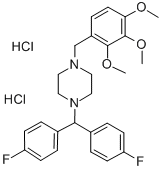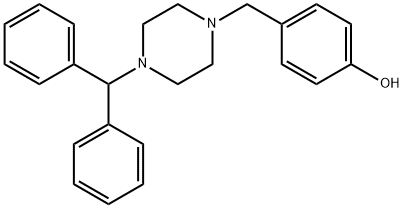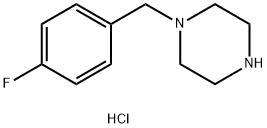LomerizineDihydrochloride , 10mMinDMSO , 101477-54-7
Synonym(s):
1-[Bis(4-fluorophenyl)methyl]-4-[(2,3,4-trimethoxyphenyl)methyl]piperazine dihydrochloride
CAS NO.:101477-54-7
Empirical Formula: C27H32Cl2F2N2O3
Molecular Weight: 541.46
MDL number: MFCD01703867
| Pack Size | Price | Stock | Quantity |
| 1ml | RMB159.20 | In Stock |
|
| others | Enquire |
PRODUCT Properties
| Melting point: | 214-218°C dec. |
| storage temp. | Inert atmosphere,2-8°C |
| solubility | DMSO: ≥30mg/mL |
| form | powder |
| color | white to tan |
| Merck | 14,5563 |
| Stability: | Stable for 1 year from date of purchase as supplied. Solutions in DMSO or ethanol may be stored at -20°C for up to 1 month. |
| CAS DataBase Reference | 101477-54-7(CAS DataBase Reference) |
Description and Uses
Lomerizine hydrochloride was introduced as Teranas and Migsis in Japan for the treatment of migraine. It is the first in its class of dual sodium and calcium channel blockers to be marketed for this indication. It can be synthetically obtained by reductive amination of 2,3,4-trimethoxybenzaldehyde with the appropiate benzhydryl piperazine. In dogs, Lomerizine exerts a potent, selective and long-lasting vasodilation of cerebral arteries related to a combination of mechanisms, especially a functional block of L-type voltagesensitive calcium channels (L-VSCCs). Lomerizine increases cerebral blood flow compared to peripheral blood flow with only weak effects on systemic arterial blood pressure. Other mechanisms involved could be blockade of other VSCC and sodium channels, 5-HT2 and alpha-1 receptors. As a reducing agent of cortical spreading depression and neurogenic inflammation, Lomerizine was shown to be useful in migraine. In an open clinical study, it demonstrated efficacy in the treatment of cluster headache. Moreover, it may have utility in other neurological diseases such as cerebrovascular ischemia or cerebral infarction.
A diphenylpiperazine calcium channel blocker. A selective cerebral vasodilator. Antimigraine.
Safety
| Symbol(GHS) |   GHS07,GHS09 |
| Signal word | Warning |
| Hazard statements | H302-H410 |
| Precautionary statements | P264-P270-P273-P301+P312-P391-P501 |
| Hazard Codes | Xn,N |
| Risk Statements | 22-50 |
| Safety Statements | 61 |
| RIDADR | UN 3077 9 / PGIII |
| WGK Germany | 3 |
| RTECS | TK9189000 |
| HS Code | 29335990 |
| Toxicity | LD50 orally in mice: 300 mg/kg (Ohtaka) |






